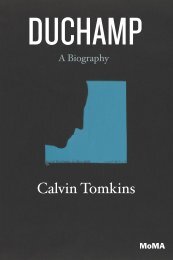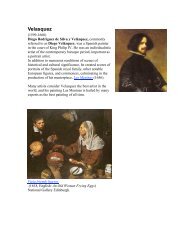Still Life in Watercolors
qbj8dgc
qbj8dgc
- No tags were found...
You also want an ePaper? Increase the reach of your titles
YUMPU automatically turns print PDFs into web optimized ePapers that Google loves.
evident, but that process is methodical and l<strong>in</strong>ear, and the relation between start and<br />
f<strong>in</strong>ish, l<strong>in</strong>e and color that it enacts is clearly sequential.<br />
Not so <strong>in</strong> the late period. <strong>Still</strong> <strong>Life</strong> with Carafe, Bottle, and Fruit offers a beautiful<br />
demonstration of how much distance Cezanne had traveled with<strong>in</strong> his still-life<br />
and watercolor process. This still life is clearly devoted to show<strong>in</strong>g its own compulsive<br />
process of mak<strong>in</strong>g—of draw<strong>in</strong>g with the pencil and pa<strong>in</strong>t<strong>in</strong>g with the watercolor<br />
brush and then draw<strong>in</strong>g and pa<strong>in</strong>t<strong>in</strong>g and draw<strong>in</strong>g aga<strong>in</strong>—thus <strong>in</strong>dex<strong>in</strong>g what<br />
goes on <strong>in</strong> the studio as well as what goes <strong>in</strong>to it. Never before did the mak<strong>in</strong>g of three<br />
different glass vessels out of the <strong>in</strong>gredients of white paper, graphite l<strong>in</strong>es, and watercolor<br />
layers reiterate itself so evidently, show<strong>in</strong>g how the concert of pa<strong>in</strong>t<strong>in</strong>g and draw<strong>in</strong>g<br />
could mimic the craft of glassblow<strong>in</strong>g, br<strong>in</strong>g<strong>in</strong>g light and dark, transparent and<br />
translucent forms <strong>in</strong>to be<strong>in</strong>g, as <strong>in</strong> this late still life. Never before did any of Cezanne's<br />
still lifes <strong>in</strong> watercolor put side by side so demonstratively the different degrees of<br />
render<strong>in</strong>g and the different ratios of watercolor to pencil needed to br<strong>in</strong>g a group of<br />
objects <strong>in</strong>to existence on the surface of a sheet of paper: very little of either (the glass),<br />
a superabundance of watercolor <strong>in</strong> relation to graphite l<strong>in</strong>e (the w<strong>in</strong>e bottle), the predom<strong>in</strong>ance<br />
of l<strong>in</strong>e over color and a surfeit of graphite (the carafe). Thus the act of<br />
mak<strong>in</strong>g carafe, bottle, and fruit by means of pencil and watercolor is as much the<br />
subject matter of the still life as the carafe, bottle, and fruit themselves, arranged <strong>in</strong><br />
the studio for pa<strong>in</strong>t<strong>in</strong>g. At the same time the process of mak<strong>in</strong>g that <strong>Still</strong> <strong>Life</strong> with<br />
Carafe, Bottle, and Fruit shows off takes the <strong>in</strong>cipient novelties of earlier works like<br />
Three Pears—the use of repeated contours, the employment of white paper as both<br />
figure and ground, volume and space, and the float<strong>in</strong>g free of patches of pencil<br />
hatch<strong>in</strong>g—and pushes them to the po<strong>in</strong>t that the old l<strong>in</strong>ear sequence from l<strong>in</strong>e and<br />
shade to color<strong>in</strong>g <strong>in</strong> is, if not <strong>in</strong>verted, stretched and opened up <strong>in</strong>to a circle, the unidirectional<br />
movement between orig<strong>in</strong>al concept and its flesh<strong>in</strong>g out converted <strong>in</strong>to a<br />
dialogue without fixed conclusion between graphite and watercolor.<br />
Much more than <strong>in</strong> the Getty still life, it is clear that Cezanne meant to let his<br />
pencil work be everywhere evident, as a crucial part of the factural effect of <strong>Still</strong> <strong>Life</strong><br />
with Carafe, Bottle, and Fruit. It is by no means underdraw<strong>in</strong>g anymore, though clearly<br />
Cezanne began by pencil<strong>in</strong>g <strong>in</strong> the composition, and it is more than likely that he<br />
made his f<strong>in</strong>al touches <strong>in</strong> watercolor. But the pencil is everywhere available to the<br />
eye; no <strong>in</strong>frared scann<strong>in</strong>g is necessary to tease it out. It is to be seen <strong>in</strong> the l<strong>in</strong>e of<br />
wall mold<strong>in</strong>g, the back and front l<strong>in</strong>es of the ledge on which the objects sit. It repeatedly<br />
marks the outl<strong>in</strong>es of fruit—seven or eight apples and a bunch of grapes; the<br />
glass that stands beh<strong>in</strong>d them; the tall, dark w<strong>in</strong>e bottle; and the transparent, widebellied<br />
carafe, replete with two different options as to where its neck ends, at the l<strong>in</strong>e<br />
of wall mold<strong>in</strong>g or <strong>in</strong> the lip that rises above it. It can be seen <strong>in</strong> the label of the w<strong>in</strong>e<br />
bottle, and <strong>in</strong> the scribbled and curv<strong>in</strong>g marks on the wall surface beh<strong>in</strong>d the still<br />
life (or is it a balcony rail<strong>in</strong>g?—probably not, but it recalls those views out open w<strong>in</strong>dows<br />
with the rail and curv<strong>in</strong>g ironwork of a balcony <strong>in</strong> the foreground, such as<br />
the one on the verso of another late landscape). 10 It is those marks, particularly the<br />
scribbl<strong>in</strong>g to the right, that most suggest the loos<strong>in</strong>g of graphite from its moor<strong>in</strong>gs<br />
128<br />
CEZANNE IN THE STUDIO




